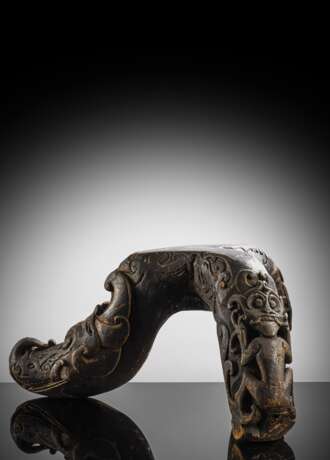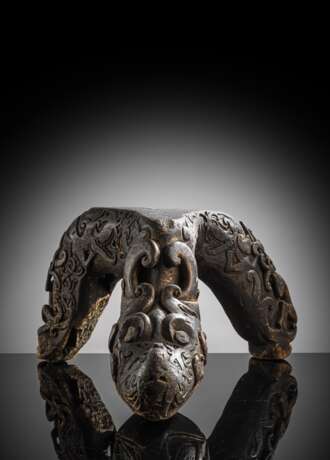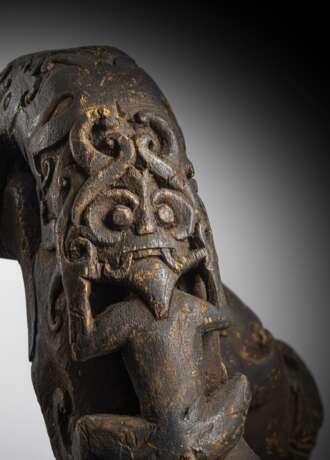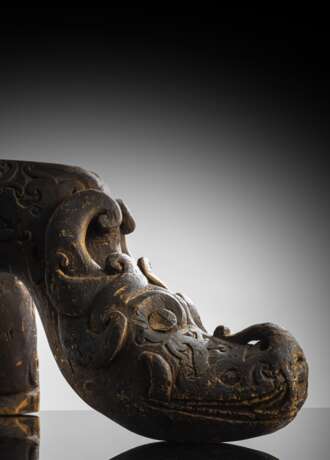ID 1218028
Lot 1511 | Seltener Zeremonialhocker
Estimate value
€ 4 000 – 6 000
29,8 x 57 x 49 cm
Dreibeiniger Ritualsitz, gefertigt aus der natürlichen Gabelung eines Baumes. Im Relief mit stilisierten abstrahierten aso-Drachenmotiven und menschlichen bzw. dämonischen apotropäischen Gestalten mit starrenden Augen und prominenten Zähnen beschnitzt. Eine braune Pigmentschicht bedeckt das Holz. Die Form erinnert an den mythischen Drachen aso (Hund), der als Beschützer und Ahnherr des Adels eine wichtige Rolle spielt. Das Drachenmotiv aso stammt ursprünglich aus der Zhou-Periode (Mitte erstes Jahrtausend v.u.Z.) als die austronesischen Vorfahren der Dayak aus dem austronesischen Stammland aus Südwest-China (Yunnan) und den östlichen Ausläufern des Himalaya nach Südostasien abwanderten. Derartige Sitze wurden von Heilern oder Schamanen manang benutzt. Sie können auch von einem hochrangigen Krieger bei der Bewirtung mit Reiswein verwendet worden sein. Außerhalb der Festzeiten waren solche Stühle vor den Wohnsitzen des Adels auf der Veranda im Langhaus aufgestellt und dokumentieren den Rang des Bewohners. Besondere Sitze waren auch bei gawai (Festivals) als Rangabzeichen und Statusausweis hochrangiger Krieger vorgesehen (im Alltag sitzen die Dayak ebenerdig auf Rattanmatten). Stühle bzw. Sitzhocker dürften in Indonesien erst im Laufe der letzten Jahrhunderte unter muslimischem Einfluss aufgekommen sein, denn auf hindu-javanischen Tempelfriesen sind sie nicht anzutreffen. Gawai Dayak, jährlich stattfindende Festivals, die mehrere Wochen dauern konnten, werden bei unterschiedlichen Anlässen durchgeführt. Sie unterscheiden sich zwischen den unterschiedlichen Dayak-Ethnien geringfügig, aber die Anlässe wie Erntedank, Aussaat, Gedenkfeiern für die Vorfahren, spirituelle Reinigungsrituale, Bestätigung der Gesellschaftsordnung sowie - früher - Sieg in intertribalen Fehden sind dieselben. Oft wird hierbei ein Stuhl bereitgestellt, wobei die hohen Ahnen aufgerufen sind, Platz zu nehmen und den Festlichkeiten beizuwohnen. Es ist wahrscheinlich, dass der vorliegende Sitz für die rituelle Platzierung eines hochrangigen Vorfahren anlässlich einem der großen Kriegsfestivals vorgesehen war.
Aus einer alten deutschen Privatsammlung, seit den 1950er Jahren gesammelt - Partiell Altersspuren und kleine Best.
Lit.: Ave, J. B. / King, V. (1986): People of the Weeping Forest. Tradition and Change in Borneo. Leiden. - Hein, A.R. (1895): Zur Entwicklungsgeschichte des Ornamentes bei den Dayaks. Wien. - Sellato, B. (1992): Hornbill and Dragon. Arts and Culture of Borneo. Sun Tree Publishing. - Taylor, P. M. / Aragon, L. V. (1990): Beyond The Java Sea. Arts of Indonesia`s Outer Islands. New York.
| Auction house category: | Ethnographic tribal art |
|---|
| Auction house category: | Ethnographic tribal art |
|---|
| Address of auction |
Nagel Auktionen GmbH Neckarstrasse 189 - 191 70190 Stuttgart Germany | ||||||||||||||
|---|---|---|---|---|---|---|---|---|---|---|---|---|---|---|---|
| Preview | |||||||||||||||
| Phone | +49 (0)711 649 690 | ||||||||||||||
| Fax | +49 (0)711 649 69696 | ||||||||||||||
| Buyer Premium | 29,5% | ||||||||||||||
| Conditions of purchase | Conditions of purchase | ||||||||||||||
| Business hours | Business hours
|






